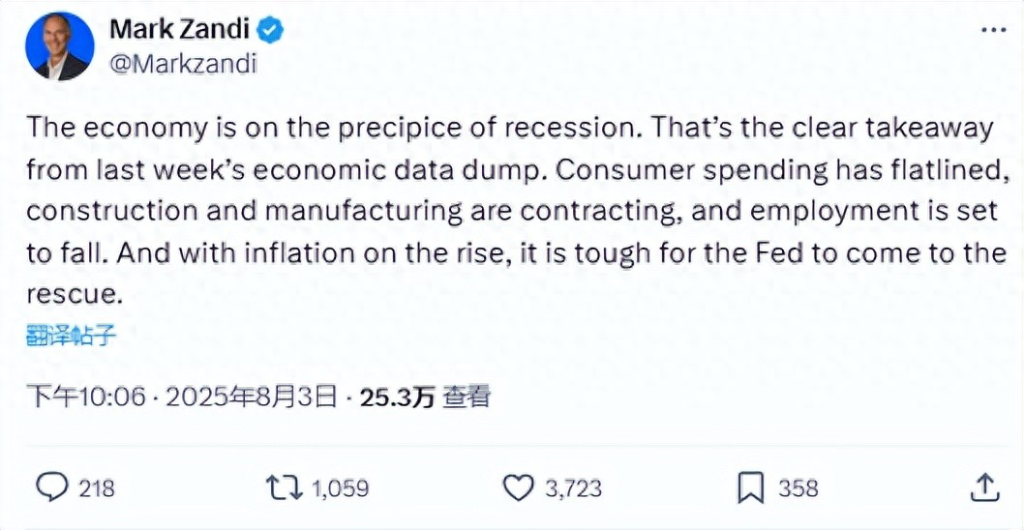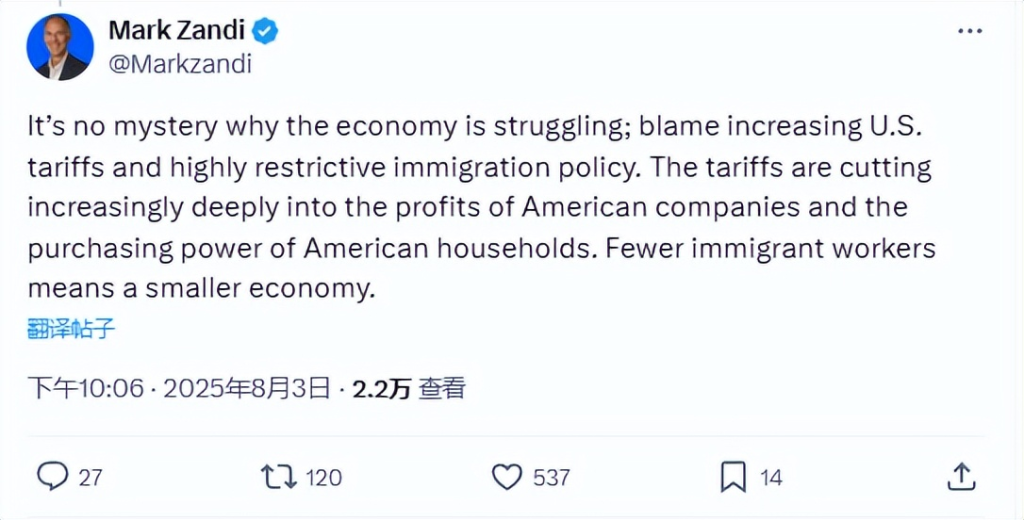On August 3 local time, Mark Zandi, Chief Economist at Moody’s, posted four consecutive tweets warning that various indicators over the past week all signal the US economy is teetering on the edge of recession.

Revised Employment Data
Incremental Gains “Wiped Out” Entirely
On August 1, the US Department of Labor released economic data showing that non-farm payrolls added 73,000 jobs in July, falling short of market expectations. Meanwhile, the previously reported figures for May and June—144,000 and 147,000 new jobs, respectively—were sharply revised downward to 19,000 and 14,000. This represents a total reduction of 258,000 jobs. Additionally, the hiring rate dropped to its lowest level in seven months, reflecting persistent weakness in the labor market and a substantial softening in business demand.
Economist: “Recession Warning Signs Flashing”
Zandi warned that not only is the US labor market weakening, but consumer spending is also flat, and both construction and manufacturing sectors are contracting. He also argued that with inflation still above the 2% target, the Federal Reserve will find it difficult to revive economic growth.
JPMorgan similarly noted that a decline in labor demand to this extent is a warning signal of recession.
Trump: “Stats Officials Are Lying”
Moody’s Analyst: “This View Is Utterly Wrong”
Dissatisfied with the latest employment data from the Labor Department, former President Donald Trump ordered the firing of Erica McEntarfer, head of the Bureau of Labor Statistics (BLS), on August 1.
On August 3, Trump took to social media again, accusing the dismissed McEntarfer of producing the “biggest error in 50 years.” Trump claimed McEntarfer had inflated job figures to “historic highs” before the 2024 election, only to revise them down by nearly one million positions after his victory—allegedly as “error corrections.” He angrily denounced this as a “fraud.”
The same day, Mark Zandi responded: “Any suggestion that economic data is distorting the actual performance of the economy is profoundly mistaken. At economic inflection points, such as recessions, data always undergoes significant revisions.”
Zandi also wryly noted the impact of mass layoffs within the US government, particularly due to disruptions caused by the “Department of Government Efficiency (DOGE),” which led to delayed data reporting from agencies to the BLS. As employment conditions become volatile, substantial data revisions naturally follow. Earlier this year, Elon Musk established DOGE with Trump’s backing, but as the two parted ways, the reforms lost momentum.

Beyond the Sharp Drop in US Jobs, What Other Data Points Are at a Turning Point?
In April, the White House launched a “US vs. The World” trade war, claiming it wouldn’t severely damage the US economy. But the recent downward revisions of May and June employment data—effectively “wiped out”—have forced a reassessment of the tariff war’s impact.
Economist: Tariffs and Immigration Policies Are Key Culprits
Zandi criticized that America’s economic woes are directly linked to escalating tariffs and highly restrictive immigration policies. Tariffs increasingly erode corporate profits and household purchasing power, while reduced immigrant labor means a smaller economy.
Compounding the woes, US inflation has rebounded, remaining above the Fed’s 2% target. Consumer spending growth has underperformed expectations, and both construction and manufacturing are contracting. In this climate, the Federal Reserve will struggle to use tools like interest rate cuts to reverse the economic downturn.
Especially now, with Trump repeatedly threatening to fire Fed Chair Jerome Powell, the central bank is not only unable to rescue the market—it finds itself embroiled in controversy.
